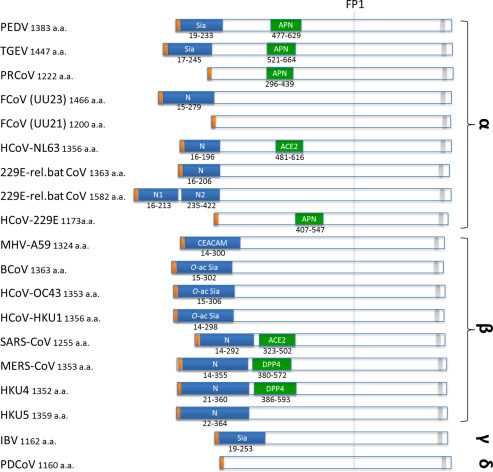Fig. 2.

Overview of currently known receptors and their binding domains within S1. Schematic representation of coronavirus spike proteins drawn to scale. Yellow boxes indicate signal peptides. Blue boxes indicate the N-terminal regions in alpha- and betacoronavirus spike proteins, which were mapped based on sequence homology between viruses within the same genus. Green boxes indicate known receptor-binding domains in the C-terminal region of S1. Known receptors are indicated in the boxes: APN, aminopeptidase N; ACE2, angiotensin-converting enzyme 2; CEACAM, carcinoembryonic antigen-related cell adhesion molecule 1; Sia, sialic acid; O-ac Sia, O-acetylated sialic acid; DPP4, dipeptidyl peptidase-4. Gray boxes indicate transmembrane domains. Spikes proteins are shown of PEDV strain CV777 (GB: AAK38656.1), TGEV strain Purdue P115 (GB: ABG89325.1), PRCoV strain ISU-1 (GB: ABG89317.1), Feline CoV strain UU23 (GB: ADC35472.1), Feline CoV strain UU21 (GB: ADL71466.1), Human CoV NL63 (GB: YP_003767.1), 229E-related bat CoV with one N domains (GB: ALK28775.1), 229E-related bat CoV with two N domains (GB: ALK28765.1), Human CoV 229E strain inf-1 (GB: NP_073551.1), MHV strain A59 (GB: ACO72893), BCoV strain KWD1 (GB: AAX38489), HCoV-OC43 strain Paris (GB: AAT84362), HCoV-HKU1 (GB: AAT98580), SARS-CoV strain Urbani (GB: AAP13441), MERS-CoV strain EMC/2012 (GB: YP_009047204), HKU4 (GB: AGP04928), HKU5 (GB: AGP04943), IBV strain Beaudette (GB: ADP06471), and PDCoV strain USA/Ohio137/2014 (GB: AIB07807). PSI-BLAST analysis using the NTR of the HCoV-NL63 S protein (residues 16–196) as a query detected two homologous regions in the first 425 residues of the 229E-related bat coronavirus spike protein (GB: ALK28765.1)—designated N1 (residues 32–213) and N2 (residues 246–422) with 32% and 35% amino acid sequence identity, respectively, suggesting a duplication of the NTR. Spike proteins are drawn to scale and aligned at the position of the conserved fusion peptide (FP1).
